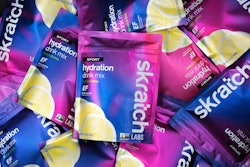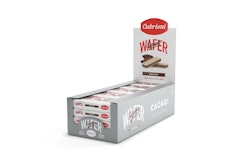Justin’s, maker of naturally delicious, high-quality nut butter and organic nut butter cups, is pioneering a new area with their latest snack innovation. In May 2019, the company became one of the first to use a high-barrier multilayer pouch constructed with 40% post-consumer recycled polyethylene in the sealant layer, making it 25% of the package overall. The pouch was developed for the company’s new line of Organic Nut Butter Covered Nuts in two varieties.
According to Justin Gold, Founder of Justin’s, the company is continuously exploring ways to improve the sustainability of its packaging. “We are driven to expand the use of sustainable packaging within our portfolio by our mission, which is focused on finding ways to contribute to our world in a positive and meaningful way,” he explains.
Justin’s began working with film converter ProAmpac at the end of July 2018 on the film, which the supplier was in the process of developing at the time. For the finished pouch, Justin’s had several aesthetic and functional requirements, including that the pack ensure food safety and quality control, meet FDA regulations, and keep ease of transport and storage in mind. Justin’s also needed the film to meet its color and image standards, created to best reflect the product and brand on shelf and ensure an aesthetic fit with the other packaging in its portfolio.
Says ProAmpac Product Development Manager Amir Saffar, “Our goal was to produce a direct food-contact laminated pouch employing FDA-compliant post-consumer recycled sealant film. We knew from experience that PCR film itself would present challenges.”
Among them, PCR film has inconsistencies that can appear as clear gels or dark specks. As Saffar explains, the imperfections are carried into the PCR film from PCR resin coming from the recycled plastic and from product labels that can’t be fully removed in the recycling process. Film made with PCR content can also present a hazy appearance.
“In the manufacturing process, we were challenged to optimize the lamination and slitting process to protect the high-barrier film from pinhole effects of the gels in PCR sealant films,” he says. “Subsequently we were challenged to ensure the pouch would be aesthetically appealing to consumers, despite these PCR imperfections.”
To overcome the hazy appearance of the film, ProAmpac adjusted the flexographic inks and employed scratch-resistant surface coatings. “The result is a striking white surface with high opacity, providing superior shelf appeal,” Saffar says. “In fact, we are proud to observe that we are achieving the surface impact of rotogravure printing with the speed and efficiency of a flexographic process.”
The pouch is made from a high-barrier print web adhesion laminated to a PE sealant containing 40% PCR plastic, which equates to 25% of the overall structure and a 30% reduction in greenhouse gas emissions. The 5 x 7½-in. package is printed in nine colors plus a matte overprint varnish and incorporates a press-to-close zipper applied on a premade pouch-making machine. According to Gold, the price of the pouch is competitive with the cost of those made from virgin materials.
On the back of the package, Justin’s has added copy that indicates the percentage of PCR in the pouch. Says Gold, “We recognize that consumers have an essential role to play when it comes to sustainable packaging, which is why education is just as important as the sourcing of sustainable materials.”
Gold adds that in the future, Justin’s hopes to move to more sustainable substrates with the help of ProAmpac. “Our goal is to continue to transition to more sustainable packaging throughout our portfolio,” he says. “Wherever possible, we are committed to sourcing recycled and renewable materials, and we encourage the most efficient use of natural resources when considering package design.”
























